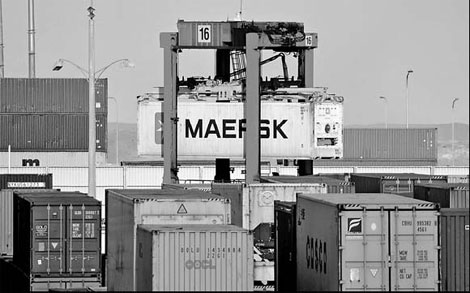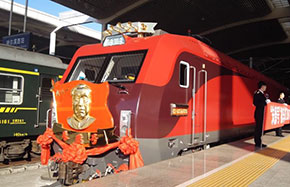Shipping industry suffering from oversupply of containers
|
Ships on the world's two busiest trade routes, Asia to Northern Europe and Asia to the Americas, are only about 85 percent full at the moment. Eric Taylor / Bloomberg |
COPENHAGEN / OSLO - The container industry may be facing half a decade of oversupply that will curb freight rates as shipping lines launch vessels into a global trade slowdown.
The rise in container capacity will exceed demand by as much as 10 percentage points over the next three years, according to Drewry Shipping Consultants Ltd. That gap won't substantially improve for five years, Neil Dekker, head of container research at Drewry, said in an Oct 11 interview. Those estimates assume no slump in world economic output.
Global growth will slow this year as "crisis-hit" advanced economies struggle and Europe's debt woes prove "tenacious", the International Monetary Fund (IMF) said last month. An increase in vessels from shipping lines such as Copenhagen-based A.P. Moeller-Maersk A/S has helped send freight rates plunging 70 percent since a 2010 peak. On its current course, the industry will struggle to turn profitable, said Ross Porter, a fund manager at Skagen A/S.
"The market outlook is pretty bleak," Porter said in an interview. The fund owns about 10,000 Maersk shares after cutting its holdings by 20 percent last month. "Given the overcapacity that's built up in the market, a few years will be required to consolidate the situation."
Capacity in the container market will rise 29 percent in the three years ending in 2013, according to data from London-based Drewry's quarterly Container Forecaster report. Demand will grow by as little as 19 percent in the period, it said.
There won't be a "major" improvement in the balance between supply and demand for five years, Dekker said. Ships on the world's two busiest trade routes, Asia to Northern Europe and Asia to the Americas, are only about 85 percent full at the moment, he said.
"Freight rates are very low," Dekker said. "It would be logical to lay up vessels, but that's not really happening."
The price to transport a full 20-foot container (TEU) from the biggest Asian ports to European ones fell to $650 in the first week of this month, according to Danske Market's container index published Oct 7. That was the lowest spot price in at least two years and compares with a peak of about $2,100 18 months ago.
The fallout from Europe's deepening debt crisis is showing signs of spreading as far as Asia as policymakers in the eurozone fail to persuade investors they can avert a Greek default. Asia faces "severe macroeconomic and financial spillovers" from deteriorating economic outlooks in Europe and the United States, the IMF said on Oct 13.
That means container shipping demand could grow even less than Drewry estimates, Dan Togo Jensen, a transport analyst at Svenska Handelsbanken AB in Copenhagen, said in an Oct 13 interview. "Box rates will be under pressure" because the imbalance between supply and demand will persist "for quite some time", he said.
Container lines have booked orders for new ships for a combined $57 billion, according to an Oct 11 estimate by Paris-based industry consultant Alphaliner. Over the next four years, new ships will add capacity equivalent to 4.5 million TEUs, compared with the current 15.2 million TEUs, according to Alphaliner.
Vessels that can haul the equivalent of about 1 million TEU will need to be idled or laid up, the Baltic and International Maritime Council, a shipping trade group, said in an Oct 13 report.
There are some signs shipping lines may reduce capacity by canceling or postponing orders for new vessels, Martin Bo Hansen, a corporate bond analyst at Jyske Bank A/S, said in an Oct 11 note.
Overcapacity may thin out the industry, with only the biggest companies surviving the pressure on freight rates, Skagen's Porter said.
"In the long term, I see Maersk coming out as the relative winner," he said. "They have the financial strength to weather this cycle, which a lot of their competitors don't."
Bloomberg News



















